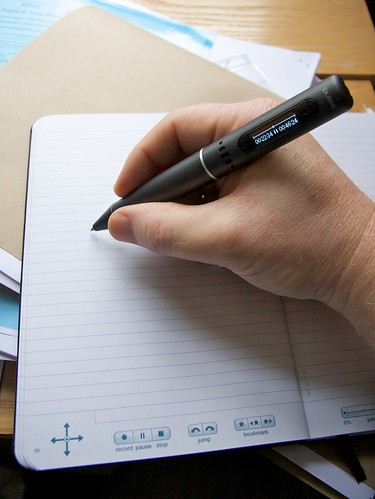My favourite recent gadget is a Livescribe Pulse. Described in their Architecture Overview as ‘a Montblanc-sized computer’, it’s a pen which incorporates the Anoto technology – there’s a small camera which points at the tip, and a very faint dot pattern on the paper which allows it to recognise its position. The upshot is that it records what you write and can transfer it to the computer when you put it in its USB dock.
The technology has been around for some time… you can get similar pens from Nokia and Logitech, and the paper is quite widely available. But there are a few things that persuaded me it was the right time to try one:
- The pen is aesthetically more pleasing, I think, than its predecessors.
- There is support for the Mac. Decidedly beta quality at present, but the 1.0 release is out on Tuesday.
- The coolest bit of all: it has a microphone built in. If you’re in a meeting, making notes, you can also be recording the audio. Later, you can tap on some text you wrote – or click on it if you’ve transferred it to your PC – and it will play back what was being said at the time you wrote the text. Quite brilliant.
There are quite a few fun things you can do with this beyond simple note-taking, and they’ve even got an SDK so, if you want to, you can write your own ‘penlet’ applications for it.
I got mine from a UK supplier, Magicomm. Livescribe have just announced another round of investment funding. They deserve to do well, I think.
Update: Bother… they’ve postponed the Mac release for a month or so.

Hi Quentin,
I’ve been using the pen for a while now, and love it as well! I’m a bioengineering major here at UC Berkeley, in California. Engineering majors, as you may know, have the pleasure of taking classes that have TONS of graphs, equations and strange symbols, so taking notes with my laptop has been out of question since day one. My handwritten notes were useful, but when I was studying for a midterm or a final, I’d come across a few parts of my notes where I thought, “What is this? Did I even write this? What does it mean?”
Hence, I started using the Pulse smartpen. Whenever I come across these “stumpers,” I just tap my notes to have my professor explain it to me all over again, as if I was in a classroom with him. 🙂
Anyway, just wanted to pop in and say that I couldn’t agree with you more regarding the pen.
Regards,
Kal
PS. In case you were thinking of buying another one of these pens as a gift or something along those lines, you may want to use the discount code: PULSE5A10 on http://www.livescribe.com. That’s what I used when I bought it, got me about $10 off. -Kal
I worked on this EXACT same concept in 1990-1991, with coordinates encoded on paper using invisible fluorescent ink to encode the coordinates that was activated by a then-non-existent blue laser (and eventually settled on IR phosphorescent ink)
The difference of course was that back in 90-91 you couldn’t miniaturize the signal processing and computing hardware to fit inside the pen so the design had a tethered pen and the computer was the size of an old-school Palm PDA.
So it took 18 years for the technology to be made a reality.
Back then people would think we’re nuts. They would ask why use a pen when you can use a keyboard.
Marc
[…] in February I wrote about my latest gadget – the LiveScribe Pulse pen. I’ve been using it extensively since then and am very pleased with […]